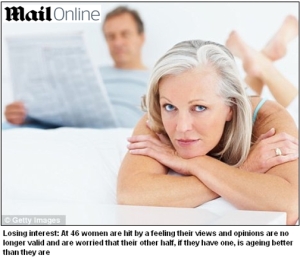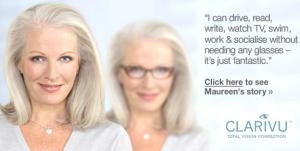When I saw this post by Dr. Brian Hughes, an academic psychologist at the National University of Ireland in Galway, I knew that I needed to run it on Flashfree. In it, Brian discusses how ageism has become the advocacy project of the month, a hook to attract attention to a specific cause by feeding into the fears and anxiety that often accompany aging. Not only are women a primary target for these campaigns, but by couching the propaganda within a scientific context, it can be difficult to discern truth from fiction.
Although this post is a bit more verbose than what I typically run, I felt it was important to include it in its entirety. I hope that you’ll show Brian some love and spread the word, not only about the post but also his work on The Science Bit Blog. Many thanks Brian, for lending me your prose this week.
There is no doubt that in our increasingly image-conscious and superficially focused times, age discrimination presents a creeping civil rights problem. The tendency to judge the professional and social worth of a person on the basis of his or her apparent age can present artificial barriers to employment and respect. Moreover, age discrimination can dramatically compound sex discrimination, as such problems are often felt more acutely by older women. Therefore, it is no surprise to see recurring campaigns to promote positive attitudes towards people right across the age-spectrum, run by charitable organizations such as Age UK as well as by publications such as Mature Times.
As with any advocacy campaign, new research that provides insights into age discrimination must be seen as important. Scientifically gathered empirical evidence can be crucial in debunking negative stereotypes and in bolstering positive claims. But, alas, not all research is the same – some is little more than advertising propaganda promulgated by capitalists who see vulnerable social groups as lucrative target markets, whose concerns about social exclusion simply make them more likely to spend their money on a solution.
Unfortunately, it appears that advocacy groups are often ill-equipped to identify the difference.
Have a look at this recent lead story on the Mature Times website: “Women feel ‘invisible’ at the age of 46, a study has revealed“. The story describes new research conducted in the UK that pinpoints 46 as the age when women’s confidence begins to “plummet“. According to the research, this is how women begin to feel after they reach that age:
…two thirds beginning to hate what they see in the mirror – most blaming the fact that they now start to have grey hair, feel uncomfortable in their clothes and have to wear numerous pairs of glasses…
…more than a quarter of women feel embarrassed at having to pull out their reading glasses in restaurants and supermarkets as they feel it’s a clear sign they are older, knocking their confidence, and adding to their ‘invisibility’…
The survey also revealed that men no longer hold doors open for four in ten, and two thirds say that they never get offered a seat in public transport. A third of women surveyed said their partners were ageing better than they were which annoyed them.
According to the Daily Mail, which covered the study in their Femail section, the research was based data gathered from more than 2,000 British women aged 40 or older. By any standards this is a very large sample. The Mail were also able to describe more of the findings:
Grey hairs, failing vision and putting on weight all make some women feel increasingly less confident as they grown older…
The researchers found that women in their mid-40s also begin to fret that their views and opinions are no longer valid…by the time they reach their mid-50s, the majority of women say they no longer receive admiring glances from strangers or compliments from the opposite sex…
…This coupled with the steady increase of over 50s requiring glasses for reading, shopping and driving add to that feeling of being older and more “invisible”…
And just in case we were having difficulty visualising a woman over the age of 46, the Mail also provide a photograph of this nice lady to illustrate what they are talking about:
Hmmm. So what’s the problem with all of this then? Surely such findings can be seen as a reasonable depiction of the experiences of British women, given that over 2,000 of them were surveyed for the study? And do they not convey many of the subtle ways in which women (and presumably men also) can become ostracized by mainstream society once they reach a certain age?
The big problem is that this is not an orthodox research study. It was not presented for publication in the scientific literature, or — as far as we can reasonably surmise — peer-reviewed prior to dissemination by independent editors (or even by a research ethics review committee). In fact, this is nothing more than market research, which means its findings are likely to be skewed by the motivations of its sponsors. And in this case, the group who commissioned the research – Clarivu – have a hugely conspicuous conflict of interest.
Clarivu are a commercial company that specialize in vision correction. They perform refractive lens exchange procedures in which the eye’s natural lens is replaced with a synthetic alternative in order to improve failing vision. Their method offers an alternative to laser eye surgery, and is effective for both short- or long-sightedness. In other words, Clarivu are in the business of offering people an alternative to wearing glasses. Yes, glasses! Those things that are repeatedly described by British women as part of the reason they feel “invisible“. And guess what — Clarivu’s services are aimed specifically at people over the age of 50. Just the age at which women begin to realise the extent to which wearing glasses is ruining their lives!
Of course, Clarivu are not a charitable organization — they do all this in return for cash. In fact, in return for UK£3,395 (around US$5,400). And that’s just forone eye. Assuming you’d like to be able to see out of both eyes rather than just the one, the full treatment will set you back the bones of £7,000/$11,000.
One amusing feature of how these results were promulgated in the media can be inferred from Clarivu’s own website. Have a look at the testimonialpresented on their website’s front page:
Look! It’s the SAME LADY as was in the Daily Mail! So, in other words, not only did Clarivu’s PR department circulate copy for publication in newspapers such as the Daily Mail, but they also provided the illustrative photographs. And, by all appearances, the Mail just transferred the lot into their own newspaper without much questioning or analysis.
What we have here is a clear case of a conflict of interest. Can we rely on the media to be an effective gatekeeper in promoting objective reporting on newly claimed research findings? Can we really rely on these findings from Clarivuthat the aging process is an emotionally negative psychological experience? Is it merely a coincidence that this large-scale survey confirms Clarivu’s marketing stance that women over 46 should seek alternatives to wearing glasses? Unfortunately, given that Clarivu have a financial interest in particular research outcomes, we simply cannot rule out the possibility of bias in their execution, analysis, or reporting of these results.
This isn’t to say that we cannot rely on Clarivu to display impeccable moral integrity. We have no evidence that they are anything other than honest in their activities. It’s just that human nature itself will create the possibility of bias whenever conflicts of interest arise. This is why the scientific method promotes principles like objectivity and replication, as well as associated practices, such as blinding and peer-review.
It is disappointing that the study was reported as actual news in the mainstream media. It is particularly ironic that it was reported as news in outlets that would ordinarily see themselves as championing the cause of, on the one hand, older adults, and on the other hand, women. This is because these so-called research findings do little to advance the cause of marginalized groups. In fact, they help maintain the social exclusion of older adults, and older women in particular, by perpetuating negative stereotypes about the aging process.
So when Mature Times report this as news, they are essentially promoting age-discrimination; and when the Daily Mail’s Femail section do so, they are encouraging readers to judge the value of women based on superficialattributes, such as whether they wear glasses after they turn 46.
Age-old problems indeed…
2 Comments
Trackbacks/Pingbacks
- Wednesday Bubble: Thin is in - eating disorders in midlife | FlashFree : Not Your Mama's Menopause - [...] menopause (and its related weight gain), empty nest syndrome and even illness. Self-esteem issues, the invisibility syndrome and the…










Wow, I have to say that I am past 46 and I feel more confident now than I ever have in my life! Anecdotal evidence? Maybe. But so much for generalizability… I never cease to be amazed by market “research.” Talk about making the data fit the hypothesis! Thanks for sharing this, Liz!
Certain British newspapers LOVE to write about topics like this, so thanks for calling out the shady research. Far from feeling like a doormat or wallflower, I feel more confident every day as I grow older. I like being older than other men and women at work and elsewhere — instant authority!! These women need to read, “What I Love About Menopause”: http://www.womentowomen.com/menopause/whatiloveaboutmenopause.aspx